
Money supply growth inched upward again in June this year, but remains well below the growth rates experienced from 2009 to 2016. Overall, June’s growth rate does not suggest a departure from the general downward slide in growth rates that’s been in place since late 2016.
In June, year-over-year growth in the money supply was at 4.4 percent. That was up from May’s growth rate of 4.2 percent, but down from June 2017’s rate of 5.4 percent.

The money-supply metric used here — the “true” or Rothbard-Salerno money supply measure (TMS) — is the metric developed by Murray Rothbard and Joseph Salerno, and is designed to provide a better measure than M2. The Mises Institute now offers regular updates on this metric and its growth.
This measure of the money supply differs from M2 in that it includes treasury deposits at the Fed (and excludes short-time deposits, traveler’s checks, and retail money funds).
M2 growth accelerated in June 2018, rising 4.2 percent, compared to May’s rate of 3.8 percent. M2 grew 5.6 percent in June of last year. Overall, though, the M2 growth rate has fallen considerably since late 2016.
Money supply growth can often be a helpful measure of economic activity. During periods of economic boom, money supply tends to grow quickly as banks make more loans. Recessions, on the other hand, tend to be preceded by periods of falling money-supply growth.
Factors at work in differences between M2 and the Rothbard-Salerno measure include treasury deposits at the Fed, which have climbed again in recent months back to near all-time highs. Rothbard-Salerno calculates money supply including these deposits as money, although M2 does not. Thus, these recent increases in treasury deposits will result — all else being equal — in more money-supply growth in the Austrian measure of the money supply, than in M2.
The Rothbard-Salerno method also removes retail money funds and small-time deposits from the money supply. In recent months, both retail money funds and small-time deposits have been increasing. So these increases, which show up in M2, are not reflected in the Austrian measure.
















